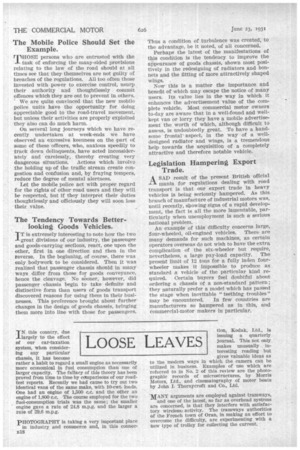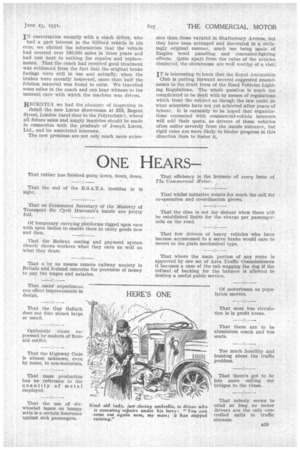LOOSE LEAVES
Page 32

Page 33

If you've noticed an error in this article please click here to report it so we can fix it.
JN this country, due largely to the effect of our car-taxation system, when considering any particular chassis, it has become rather a habit to regard a small engine as necessarily more economical in fuel consumption than one of larger capacity. The fallacy of this theory has been proved from time to time by comparisons of our roadtest reports. Recently we had cause to try out two Identical vans of the same make, with 10-cwt. loads. One had an engine of 1,500 c.c. and the other an engine of 1,800 c.c. The course employed for the two fuel-consumption trials was the same; the smaller engine gave a rate of 24.8 m.p.g. and the larger a rate of 29.6 m.p.g.
PHOTOGRAPHY is taking a very important place in industry and commerce and, in this connecB18 tion, Kodak, Ltd., is issuing a quarterly journal. This not only makes unusually interesting reading but gives valuable ideas as to the modern ways in which the camera can be utilized in business. Examples of use which are referred to in No. 2 of this review are the photographic records of microstructures, by Morris Motors, Ltd., and cinematography of motor boats by John I. Thornycroft and Co., Ltd.
MANY arguments are employed against tramways, and one of the latest, so far as overhead systems are concerned, is that they interfere with satisfactory wireless; activity. The tramways authorities of the French town of Oran, in making an effort to overcome the difficulty, are experimenting with a new type of trolley for collecting the current.
IN conversation recently with a coach driver, who had a part interest in the Gifford vehicle in his care, we elicited the information that the vehicle had covered over 180,000 miles in three years and had cost next to nothing for repairs and replacements. That the coach had received good treatment was evidenced from the fact that the original brake facings were still in use and actually; when the brakes were-recently inspected, more than half the friction material was found to exist. We travelled some miles in the coach and can bear witness to the unusual care with which the machine was driven.
RECENTLY we had the pleasure of inspecting in detail the new Lucas showrooms at 319, Regent Street, London (next door to the Polytechnic), where all future sales and supply inquiries should be made in connection with the produc.ts of Joseph Lucas, Ltd., and its associated interests.
The new premises are not only much more .exten
sive than. those vacated in Shaftesbury Avenue, but they have been arranged and decorated in a strikingly original manner, much use being made of Empire wood panelling and concealed-lighting effects. Quite apart from the value of the articles displayed, the showrooms are well worthy of a visit: IT is interesting to learn that the Royal Automobile
Club is putting forward several suggested amendments to the draft form of the Road Vehicles Lighting Regulations. • The. whole question is much too complicated to be dealt with by means of regulations which 'treat the subject as though the law could do What scientists have not yet achieved after years of labour. It is earnestly to be hoped that organizations connected with commercial-vehicle interests will add their quota, as. drivers of these vehicles often suffer severely from the dazzle nuisance, but rigid rules are more likely to hinder progress in this direction than to foster it.




























































































